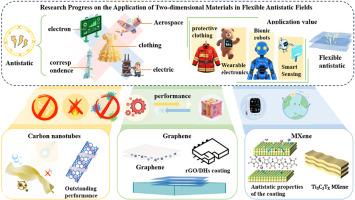Research Progress on the Application of Two-dimensional Materials in Flexible Antistatic Fields
IF 9.7
2区 材料科学
Q1 MATERIALS SCIENCE, MULTIDISCIPLINARY
引用次数: 0
Abstract
Static electricity presents a significant challenge in flexible applications—including protective clothing, wearable electronics, bionic robotics, and smart sensing—necessitating high-performance antistatic solutions. Two-dimensional materials (notably carbon nanotubes, graphene, and MXene) have emerged as core components for enhancing the antistatic performance of flexible systems, leveraging their exceptional conductivity and tunable interfacial characteristics. This work focuses on these three materials, transcending traditional methodological limitations. Grounded in percolation theory and interface science, we systematically and comprehensively compare their key performance dimensions in flexible antistatic applications for the first time. Critical dimensions analyzed include: conductive mechanisms, flexibility contributions, dispersion stability, processing compatibility, interfacial bonding strength, environmental stability, and optical transparency. This comparative analysis clarifies their respective applicability scenarios. Building on this multi-dimensional assessment, we identify critical technological bottlenecks and prospectively discuss future development directions: multi-functional integration, intelligent responsiveness, and green sustainability. Our analysis aims to provide scientific guidance and actionable insights to advance next-generation high-performance intelligent flexible antistatic materials.

二维材料在柔性抗静电场中的应用研究进展
静电在包括防护服、可穿戴电子产品、仿生机器人和智能传感在内的灵活应用中提出了重大挑战,需要高性能的防静电解决方案。二维材料(特别是碳纳米管,石墨烯和MXene)已经成为增强柔性系统抗静电性能的核心部件,利用其卓越的导电性和可调的界面特性。这项工作的重点是这三种材料,超越了传统的方法限制。基于渗流理论和界面科学,我们首次系统、全面地比较了它们在柔性抗静电应用中的关键性能维度。分析的关键维度包括:导电机制、柔韧性贡献、分散稳定性、加工兼容性、界面结合强度、环境稳定性和光学透明度。通过对比分析,明确了它们各自的适用场景。在此多维度评估的基础上,我们确定了关键的技术瓶颈,并展望了未来的发展方向:多功能集成、智能响应和绿色可持续性。我们的分析旨在为下一代高性能智能柔性抗静电材料的发展提供科学指导和可操作的见解。
本文章由计算机程序翻译,如有差异,请以英文原文为准。
求助全文
约1分钟内获得全文
求助全文
来源期刊

Materials Today Physics
Materials Science-General Materials Science
CiteScore
14.00
自引率
7.80%
发文量
284
审稿时长
15 days
期刊介绍:
Materials Today Physics is a multi-disciplinary journal focused on the physics of materials, encompassing both the physical properties and materials synthesis. Operating at the interface of physics and materials science, this journal covers one of the largest and most dynamic fields within physical science. The forefront research in materials physics is driving advancements in new materials, uncovering new physics, and fostering novel applications at an unprecedented pace.
 求助内容:
求助内容: 应助结果提醒方式:
应助结果提醒方式:


